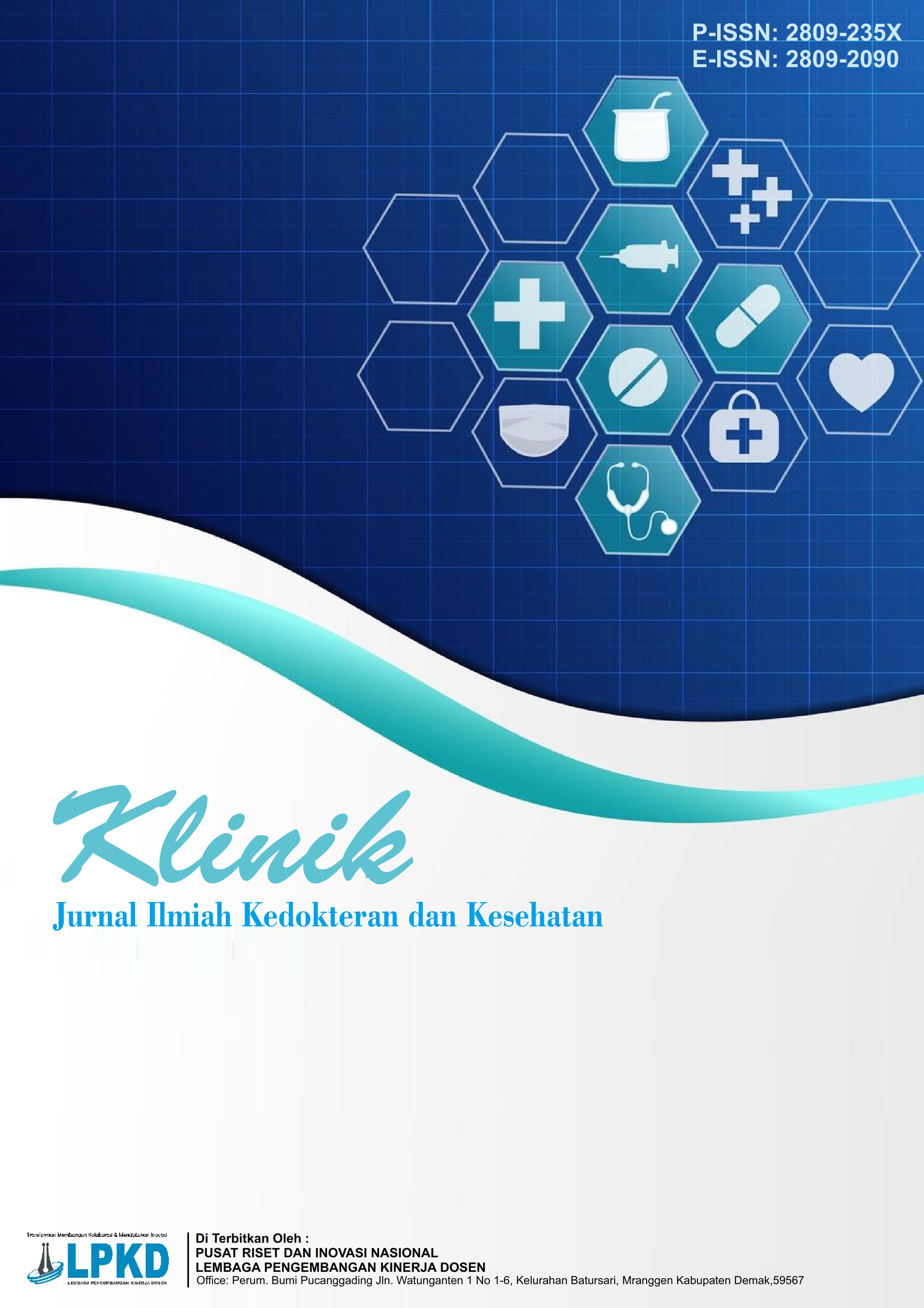Analisis Korelasi antara Faktor Kesehatan Wilayah dan Jumlah Kasus Difteri di Kabupaten Sampang Tahun 2023
DOI:
https://doi.org/10.55606/klinik.v4i3.4590Keywords:
Diphtheria, Malnutritition, Health Facilities, Population DensityAbstract
Diphtheria is an infectious disease that is still a public health problem, including in Sampang Regency which recorded the highest number of cases in East Java Province in 2023. This study aims to analyze the relationship between several health factors that are suspected to have an effect on the number of diphtheria cases in Sampang Regency. This study uses a quantitative approach with an observational analytical design and uses secondary data from 14 sub-districts in Sampang Regency. The variables analyzed included the number of undernourished toddlers, the percentage of DPT immunization coverage, population density, the percentage of unhealthy houses, and the ratio of health facilities. The results of the Pearson correlation test showed that there were three variables that had a significant relationship with the number of diphtheria cases, namely the number of undernourished toddlers (r = 0.589; p-value = 0.027), population density (r = 0.768; p-value = 0.001), and the ratio of health facilities (r = 0.543; p-value = 0.045). Meanwhile, the variables of the percentage of DPT immunization coverage and the percentage of unhealthy houses did not show a significant relationship. These findings emphasize the importance of improving nutritional status, managing population density, and improving access to health services as a diphtheria control strategy.
References
Arifin, I. F., & Prasasti, C. I. (2017). Faktor yang berhubungan dengan kasus difteri anak di Puskesmas Bangkalan tahun 2016. Jurnal Berkala Epidemiologi, 5(1), 26–36. https://doi.org/10.20473/jbe.v5i1.2017.26-36
Arini, D., Kulsum, S., & Mayasari, A. C. (2020). Status kelengkapan imunisasi difteri pada kejadian difteri di wilayah Surabaya. Jurnal Ilmiah Keperawatan Stikes Hang Tuah Surabaya, 15(2), 218–232. https://doi.org/10.30643/jiksht.v15i2.117
Ayuningtyas, A. (2023). Analisis hubungan kepadatan penduduk dengan kejadian demam berdarah dengue (DBD) di Provinsi Jawa Barat. Jurnal Ilmiah Permas: Jurnal Ilmiah STIKES Kendal, 13(2), 419–426. https://doi.org/10.32583/pskm.v13i2.772
Azzahra, T. (2023). Pemodelan regresi hurdle negative binomial pada jumlah kasus difteri Jawa Barat 2020. Jurnal Riset Statistika, 3(2), 125–130. https://doi.org/10.29313/jrs.v3i2.3014
Dinkesprov Jawa Timur. (2024). Profil Kesehatan Provinsi Jawa Timur 2023.
Fardani, S. A., & Wahyono, T. Y. M. (2023). Distribusi kasus difteri, riwayat imunisasi difteri, tingkat keparahan gejala dan risiko kematian pada penderita difteri di Indonesia tahun 2020–2022. Jurnal Epidemiologi Kesehatan Indonesia, 7(2), 77. https://doi.org/10.7454/epidkes.v7i2.7468
Kemenkes RI. (2017). Pedoman pencegahan dan pengendalian difteri. https://sehatnegeriku.kemkes.go.id/wp-content/uploads/2018/01/buku-pedoman-pencegahan-dan-penanggulangan-difteri.pdf
Kemenkes RI. (2024). Profil Kesehatan Indonesia 2023. https://kemkes.go.id/id/profil-kesehatan-indonesia-2023
Mardiana, D. E. (2018). The influence of immunization and population density to diphtheria’s prevalence in East Java. Jurnal Berkala Epidemiologi, 6(2), 122–129. https://doi.org/10.20473/jbe.v6i22018.122-129
Ningsih, R. (2023). Faktor yang berkaitan dengan kejadian difteri berdasarkan analisis spasial di Provinsi Jawa Timur [Universitas Airlangga]. https://ir.unair.ac.id/opac/detail-opac?id=e77cc57bbb20cc8450ffba02df3167d493469bbc
Notoatmodjo, S. (2014). Prinsip-prinsip dasar ilmu kesehatan masyarakat. PT. Rineka Cipta.
Prabowo, J., & Iriani, D. U. (2019). Hubungan antara faktor lingkungan fisik rumah dan karakteristik individu terhadap kejadian difteri di Kabupaten Tangerang. Journal of Religion and Public Health, 1(1), 20–25. https://doi.org/10.15408/jrph.v1i1.12518
Puspitasari, M. (2021). Literature review: Penyakit infeksi dengan status gizi pada balita. Jurnal Kesehatan, 14(1), 18–22. https://doi.org/10.32763/juke.v14i1.250
Rosalina, S., Hz, H., & Rawalilah, H. (2023). Penyuluhan tentang rumah sehat dalam upaya pencegahan penyakit berbasis lingkungan di Kelurahan 26 Ilir Palembang tahun 2023. Jurnal Pengabdian Masyarakat Indonesia, 3(3), 207–220.
Suratno, S. A., & Hendrati, L. Y. (2023). Risk factors for diphtheria incidence in East Java: Underweight status, coverage of DPT-HB-HiB3 (2019–2021 period). Media Gizi Kesmas, 12(2), 854–859. https://doi.org/10.20473/mgk.v12i2.2023.854-859
WHO. (2018). Vaccine-preventable diseases surveillance standards. Emerging Infectious Diseases, 4(3). https://doi.org/10.3201/eid0403.980314
WHO. (2020). Malnutrition.
WHO. (2024). Diphtheria – number of reported cases. https://www.who.int/data/gho/data/indicators/indicator-details/GHO/diphtheria---number-of-reported-cases
Downloads
Published
How to Cite
Issue
Section
License
Copyright (c) 2025 Jurnal Ilmiah Kedokteran dan Kesehatan

This work is licensed under a Creative Commons Attribution-ShareAlike 4.0 International License.








